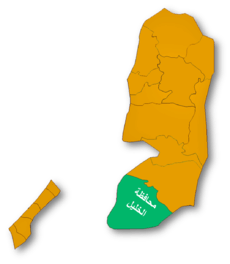Al-Majd, Hebron
al-Majd (Arabic: خربة المجد) is a Palestinian village located eighteen kilometers south-west of Hebron. The village is in the Hebron Governorate Southern West Bank.
al-Majd | |
|---|---|
| Arabic transcription(s) | |
| • Arabic | خربة المجد |
 al-Majd Location of al-Majd within Palestine | |
| Coordinates: 31°28′50″N 34°57′01″E | |
| Palestine grid | 145/098 |
| State | State of Palestine |
| Governorate | Hebron |
| Government | |
| • Type | Village council |
| Population (2007) | |
| • Total | 1,925 |
| Name meaning | Glory[1] |
History
Ceramics from the Byzantine era have been found here.[2]
Ottoman era
In 1863, Victor Guérin called it Khirbet Medjed.[3]
In 1883 the PEF's Survey of Palestine found here "Caves, cisterns, and pillar shafts; a ruined chapel seems to have stood there".[4]
1948-1967
In the wake of the 1948 Arab–Israeli War, and after the 1949 Armistice Agreements, Al-Majd came under Jordanian rule.
The Jordanian census of 1961 found 466 inhabitants in Al-Majd.[5]
1967-present
After the Six-Day War in 1967, Al-Majd has been under Israeli occupation.
According to the Palestinian Central Bureau of Statistics, the village had a population of 1,925 in 2007.[6]
References
- Palmer, 1881, p. 404
- Dauphin, 1998, p. 962
- Guérin, 1869, pp. 345-346: "d'autres ruines, très-étendues, sur les pentes et sur le sommet d'une haute colline, sollicitent mon examen : elles se nomment Khirbet Medjed, mot qui est à la fois arabe et hébreu, el qui signifie "gloire, honneur, excellence." Cette localité porte donc probablement encore aujourd'hui la dénomination qu'elle avait autrefois, bien que ni la Bible, ni l'historien Josèphe, ne fassent mention d'une ville ainsi appelée dans la tribu de Juda. Quoi qu'il en soit, on observe en cet endroit des vestiges considérables de nombreuses constructions en pierres bien équarries, les unes d'un grand appareil, les autres de dimension moyenne. Des silos, des citernes, des souterrains, qui ne sont plus connus maintenant que des bergers, auxquels ils offrent un asile, ont été pratiqués sur beaucoup de points."
- Conder and Kitchener, 1883, SWP III, p. 375
- Government of Jordan, Department of Statistics, 1964, p. 23
- 2007 PCBS Census Palestinian Central Bureau of Statistics. p.119.
Bibliography
- Conder, C.R.; Kitchener, H.H. (1883). The Survey of Western Palestine: Memoirs of the Topography, Orography, Hydrography, and Archaeology. 3. London: Committee of the Palestine Exploration Fund.
- Dauphin, Claudine (1998). La Palestine byzantine, Peuplement et Populations. BAR International Series 726 (in French). III : Catalogue. Oxford: Archeopress. ISBN 0-860549-05-4.
- Government of Jordan, Department of Statistics (1964). First Census of Population and Housing. Volume I: Final Tables; General Characteristics of the Population (PDF).
- Guérin, V. (1869). Description Géographique Historique et Archéologique de la Palestine (in French). 1: Judee, pt. 2. Paris: L'Imprimerie Nationale.
- Palmer, E.H. (1881). The Survey of Western Palestine: Arabic and English Name Lists Collected During the Survey by Lieutenants Conder and Kitchener, R. E. Transliterated and Explained by E.H. Palmer. Committee of the Palestine Exploration Fund.
External links
- Welcome To Khirbat al-Majd
- Survey of Western Palestine, Map 21: IAA, Wikimedia commons
- Al Majd Village (Fact Sheet), Applied Research Institute–Jerusalem (ARIJ)
- Al Majd Village Profile, ARIJ
- Al Majd Village Area Photo, ARIJ
- The priorities and needs for development in Al Majd village based on the community and local authorities’ assessment, ARIJ
